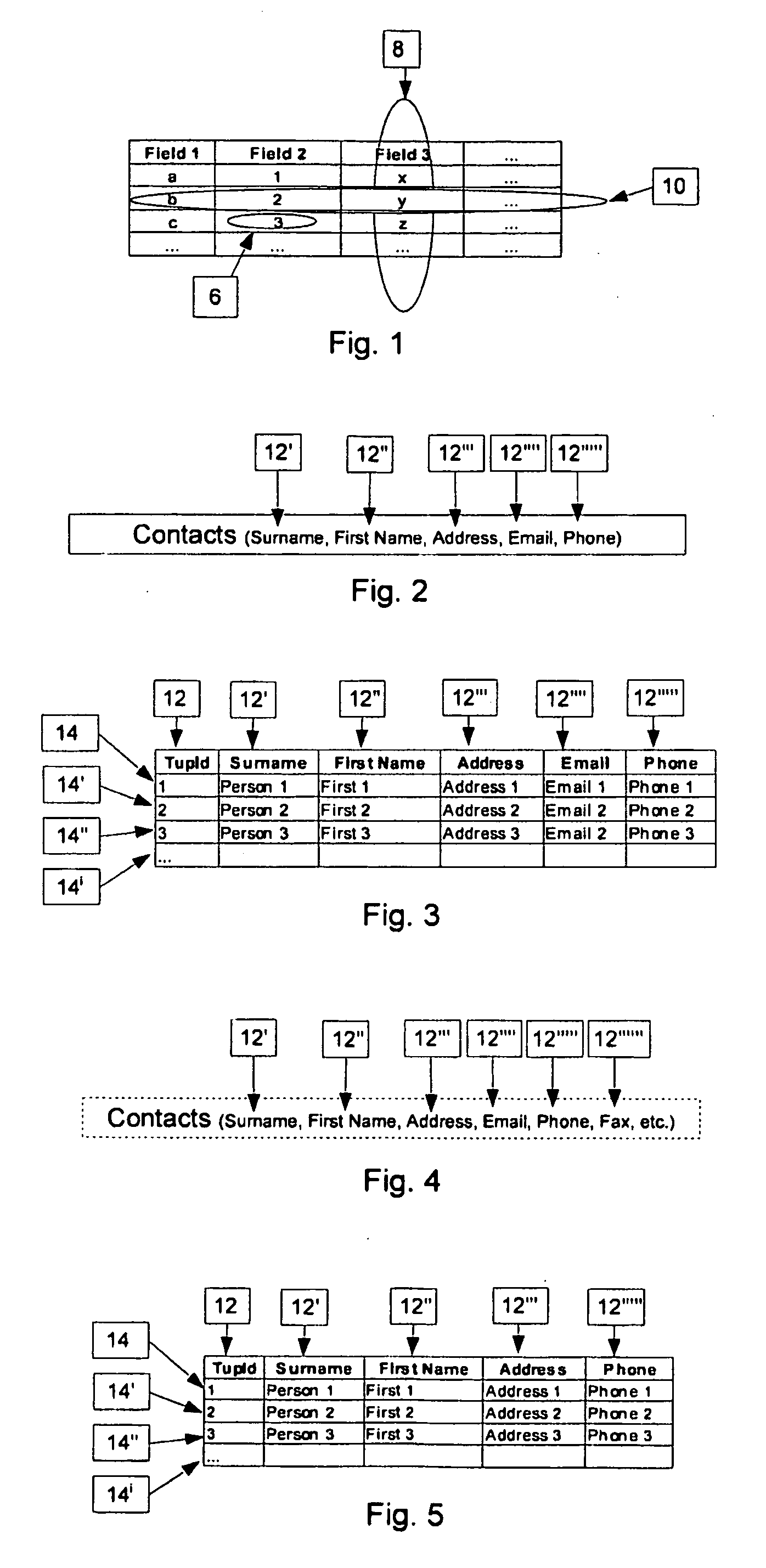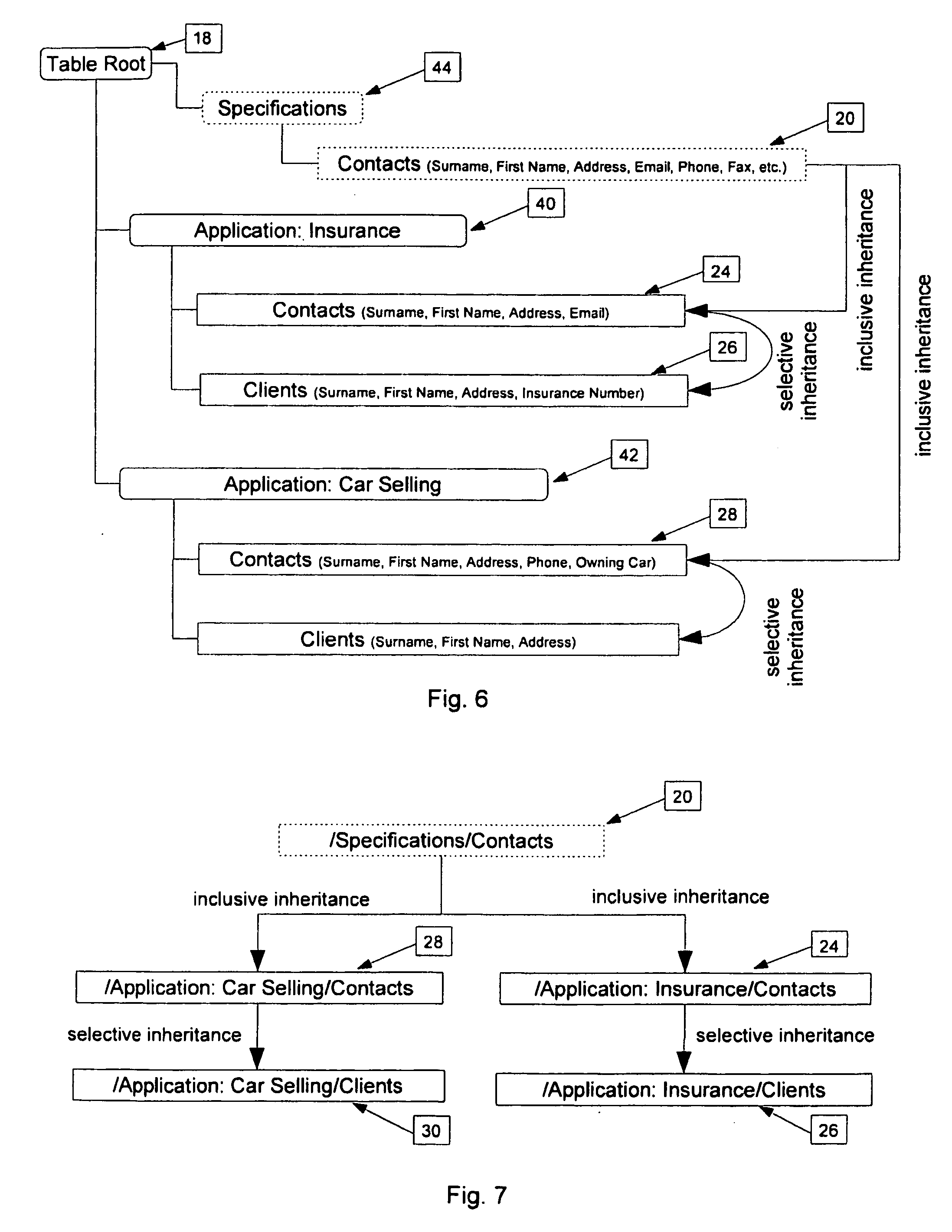Method for providing or operating a framework for the realization of independently developed programs
a technology for developing programs and operating frameworks, applied in the direction of specific program execution arrangements, program control, structured data retrieval, etc., can solve problems such as significant expenses, and achieve the effect of flexible system and difficult managemen
- Summary
- Abstract
- Description
- Claims
- Application Information
AI Technical Summary
Benefits of technology
Problems solved by technology
Method used
Image
Examples
example 1
Inclusive Inheritance
[0197]The method by which a specific application performs a query on an “inclusively inherited” database table is described, taking as an example the database table “Contacts”, labeled 36, within “Application: Car Selling”, labeled 42 having the following properties:[0198]The database table 36 is “inclusively inherited”.[0199]This inherited database table extends the table fields of the parent database table by the table field “Owning car”, labeled 50. The only physical entry of this database table is the tuple consisting of the the table field “TupId”, labeled 52, carrying the entry “2” and the table field “Owning Car” carrying the entry “Brand1-Model1 ”.
[0200]The query shall be as follows:
[0201]Return all tuples including the table fields “Surname”, “First Name”, “Address”, “Phone” and “Owning Car” with the following constraint: The table field with the name “First Name” shall be equal to the entry “William”. This query activates the following sequence:
[0202]1...
example 2
Inclusively Inheritance
[0207]As another example, the same query as in “Example 1” is performed only differing in the entry of the query-“Stephen” instead of “William”:
[0208]Return all tuples including the table fields “Surname”, “First Name”, “Address”, “Phone” and “Owning Car” with the following constraint: The table field with the name “First Name” shall be equal to the entry “Stephen”.
[0209]This query activates the following internal sequence within the framework:
[0210]1) Same as in 1) of Example 1.
[0211]2) Same as in 2) of Example 1.
[0212]3) The query is performed on the database table identified in 2). The tuples resulting from the query include table fields which are present in, i.e. inherited from, the database table on which the query is performed and which match the query. Hence, all table fields are queried except for the table field “Email”. The result is one tuple carrying the unique key table field “TupId” of the entry “2”, “Surname” with the entry “McPherson”, “First N...
example 3
Selective Inheritance
[0215]The method of performing a query on a selectively inherited database table will now be described, taking as an example the database table “Clients”, labeled 34 within application “Insurance”, 40, having the following properties:[0216]Database table 34“selectively” inherits “Contacts”, 232 within the same application.[0217]Database table 34 extends the table fields of the inheriting database table by the table field “Insurance Number”, labeled 48. The physical entries of this database table are the tuple carrying the table fields “ID” with the entries “2” and “3” and “Insurance Number” with the entries “123 / 456” and “123 / 654”.
[0218]The query shall be as follows:
[0219]Return all tuples including the table fields “Surname”, “First Name” and “Insurance Number” with the following constraint: The table field with the name “First Name” shall be equal to the entry “William”.
[0220]This query activates the following internal sequence within the framework:
[0221]1) Th...
PUM
 Login to View More
Login to View More Abstract
Description
Claims
Application Information
 Login to View More
Login to View More - R&D
- Intellectual Property
- Life Sciences
- Materials
- Tech Scout
- Unparalleled Data Quality
- Higher Quality Content
- 60% Fewer Hallucinations
Browse by: Latest US Patents, China's latest patents, Technical Efficacy Thesaurus, Application Domain, Technology Topic, Popular Technical Reports.
© 2025 PatSnap. All rights reserved.Legal|Privacy policy|Modern Slavery Act Transparency Statement|Sitemap|About US| Contact US: help@patsnap.com



